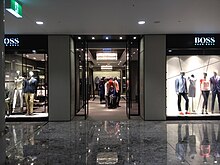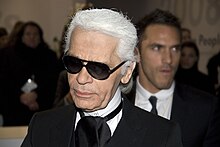German fashion

Germany plays an important role in the fashion industry, along with France, the United Kingdom, the United States, Italy, Spain, and Japan. German fashion is known for unconventional young designers and manufacturers of sports and outdoor clothing, ready-to-wear and custom-made creations.[1]
Berlin, the country's capital city, is also a fashion capital of the world and the home of Berlin Fashion Week, the country's main event where young and creative German fashion designers showcase unique creations.[2] Other important cities to the German fashion landscape are Munich,[3] Hamburg and Cologne.[4] Smaller places such as Herford, Metzingen, Herzogenaurach, Schorndorf, Chemnitz, Albstadt and Detmold[5] are also important design and production hubs of the German fashion industry.
Cities
[edit]Berlin
[edit]
Berlin Fashion Week (Berliner Modewoche) is a fashion week held twice annually (in January and July) in Berlin, Germany. Since its establishment in July 2007 it has gained great international attention for its many creative young designers who are flourishing in the fashion capital of Berlin.[6] Since July 2011, the event has taken place part in front of the Brandenburg Gate.
Mercedes-Benz is the main sponsor of the fashion week.
Zalando SE is a publicly traded German online retailer of shoes, fashion and beauty active across Europe, headquartered in Berlin. The company was founded in 2008 by David Schneider and Robert Gentz and has more than 51 million active users in 25 European markets.
Zalando is active in a variety of business fields – from multi-brand online shopping (including their own brands), the shopping club Lounge by Zalando, outlets in 12 German cities, as well as logistics and marketing offers for retailers. In 2022, Zalando generated revenue of 10.3 billion Euro, with roughly 16,000 employees.
Düsseldorf
[edit]
Düsseldorf has been the fashion capital of Germany for decades; it is also a major cultural center for the art scene. Berlin, Germany's 'fashion capital' until 1945, lost its position because of its special location within the Soviet occupation zone. After the monetary reform of June 20, 1948, fashionable clothes trends gained importance. Igedo organised fashion shows staged in Düsseldorf starting in March 1949.[7] There are a number of schools dedicated to fashion design in Düsseldorf, among them Akademie Mode & Design (de), Design Department, and Mode Design College.[8]
The Königsallee is an urban boulevard and is noted for both the landscaped canal that runs along its center, as well as for the fashion showrooms and luxury retail stores located along its sides.
Nicknamed Kö (German pronunciation: [køː] ) by locals, the Königsallee is one of Germany's busiest upscale shopping streets.[9]
Economy
[edit]In around 1,300 companies with more than 130,000 employees, a revenue of 28 billion Euro is generated by the German textile industry. Almost 44 percent of the products are exported. The textile branch thus is the second largest producer of consumer goods in Germany, after food production.[10][11]
Adidas
[edit]
Adidas AG (German pronunciation: [ˈʔadiˌdas] ; stylized in all lowercase since 1949)[12] is a German athletic apparel and footwear corporation headquartered in Herzogenaurach, Bavaria, Germany. It is the largest sportswear manufacturer in Europe, and the second largest in the world, after Nike.[13][14] It is the holding company for the Adidas Group, which also owns an 8.33% stake of the football club Bayern Munich,[15] and Runtastic, an Austrian fitness technology company. Adidas's revenue for 2018 was listed at €21.915 billion.[16]
The company was started by Adolf Dassler in his mother's house. He was joined by his elder brother Rudolf in 1924 under the name Gebrüder Dassler Schuhfabrik ("Dassler Brothers Shoe Factory"). Dassler assisted in the development of spiked running shoes (spikes) for multiple athletic events. To enhance the quality of spiked athletic footwear, he transitioned from a previous model of heavy metal spikes to utilising canvas and rubber. Dassler persuaded U.S. sprinter Jesse Owens to use his handmade spikes at the 1936 Summer Olympics. In 1949, following a breakdown in the relationship between the brothers, Adolf created Adidas and Rudolf established Puma, which became Adidas's business rival.[17]
The three stripes are Adidas's identity mark, having been used on the company's clothing and shoe designs as a marketing aid. The branding, which Adidas bought in 1952 from Finnish sports company Karhu Sports for the equivalent of €1,600 and two bottles of whiskey,[18][19] became so successful that Dassler described Adidas as "The three stripes company".[18][19]Puma
[edit]
Other Brands
[edit]
Other famous fashion brands include MCM, Hugo Boss, Escada, JOOP!, Bruno Banani, Jil Sander, Triumph, Schiesser, Closed, Reusch, Valisere, Jack Wolfskin, Ulla Popken, Buffalo, Rohde, Marc O'Polo, Tom Tailor, s.Oliver, Esprit, Wunderkind, Seidensticker, Windsor., Jaques Britt, Naketano.
There are also various agencies hosting multiple German brands and designers at once, such as zLabels Berlin.[22] Also the big department stores like Kaufhof and Karstadt, retail chains like Peek & Cloppenburg, Ulla Popken and NewYorker or mail order and online shops like Otto and Zalando have various in-house fashion brands.
Fairs
[edit]The Bread & Butter in Berlin[23] is a leading trade fair for street fashion and ready-to-wear trends, twice annually during Berlin Fashion Week.[2][24][25] The Igedo fair Collection Première Düsseldorf in Düsseldorf (CPD) was the world's dominating fashion fair for years.[26]
Designers
[edit]
Renowned fashion designers from Germany are e.g. Karl Lagerfeld, Hugo Boss, Wolfgang Joop, Jil Sander, Michael Michalsky, Etienne Aigner, Tomas Maier, Robert Geller, Philipp Plein, Rudolph Moshammer, Torsten Amft, Uli Herzner, Gabriele Strehle, Christoph Tisch, Marc Engelhard,[27] Willy Bogner, Rudolf and Adi Dassler.[28]
Media
[edit]Important fashion media of Germany include the German Vogue, Elle, InStyle, Cosmopolitan, Vanity Fair, Jolie, Glamour, Grazia, Life&Style and Sleek magazines. The German fashion magazine with the longest continued tradition is Burda Style, that was first published by Aenne Burda in 1950, who also established the major Bauer Media Group. Also various general women magazines and tabloids like Joy, Brigitte, Petra, Gala and Bunte are influential in regards to fashion perception.
As for television, FashionTV can be received via cable or satellite. Various casting shows reach a large audience in Germany, including Germany's Next Topmodel by Heidi Klum. Also on ProSieben, the series Fashion Hero starring Claudia Schiffer was looking for fashion design talents. The Shopping Queen format at VOX stars designer Guido Maria Kretschmer, it provides five contestants with 500 EUR to buy them a fashion outfit and styling in four hours, to compete with each other.
Agencies
[edit]Important modeling agency locations in Germany are Berlin (izaio, CORE Artist Management, Seeds Models, Viva Models, OneEins), Munich (Louisa Models, Most Wanted Models, Munich Models, Nova Models, Talents München, Vivienne Models) and Hamburg ( CORE Artist Management, MGM Models, iconic management, m 4 models, Mega Models, Model Management, Modelwerk, Most Wanted Models, Place Models, PMA Models). Also agencies in Vienna and Zurich host models based in Germany, as well as major global agencies like IMG Models, DNA, Elite, Models 1 and NEXT.[29]
Models
[edit]There is a range of fashion models from Germany that made it to international fame, such as Claudia Schiffer, Heidi Klum, Diane Kruger, Eva Padberg, Toni Garrn, Julia Stegner, Tatjana Patitz, Anna Ewers, Manon von Gerkan, Birte Glang, Nico, Uschi Obermaier, Carola Remer, Franziska Knuppe, Vanessa Hegelmaier, Lena Gercke, Sara Nuru, Barbara Meier, Nadja Auermann, Claudia Ciesla, Aslı Bayram, Shermine Shahrivar, Evelyn Sharma, Victoria Jancke, Marten Laciny, Nico Schwanz and Lars Burmeister.[30]
Education
[edit]Fashion education in Germany is centered on art schools, universities and the major fashion manufacturers.[31]
Academic institutions that offer courses in fashion design include:
- Multiple locations
- Berlin, Düsseldorf, Hamburg, Munich: AMD Academy of Fashion and Design[32][33]
- Leipzig, Schwerin: Design Hochschule[34]
- Berlin

- Berlin University of the Arts[35]
- HTW Berlin
- Lette-Verein Berlin Fashion and Design School
- Weissensee Academy of Arts[36]
- Atelier Chardon Savard Berlin
- Others
- Bremen: University of the Arts Bremen
- Düsseldorf: Kunstakademie Düsseldorf
- Halle: Giebichenstein Castle Academy of Arts
- Hamburg: HAW Hamburg
- Karlsruhe: Academy of Fine Arts
- Munich: Academy of Fine Arts
- Nuremberg: Academy of Fine Arts
References
[edit]| Part of a series on the |
| Culture of Germany |
|---|
 |
| Festivals |
| Music |
- ^ Stars tragen deutsche Mode Archived 2014-10-28 at the Wayback Machine (Stars wear German fashion), Vogue, August 12, 2013, retrieved January 18, 2014 (German)
- ^ a b "Berlin as a fashion capital: the improbable rise". Fashion United UK. Retrieved 24 May 2014.
- ^ Munich - The stuff dreams are made of (German), Welt
- ^ Men’s Fashions in Cologne, Cologne developed into the capital of men’s fashion in the Federal Republic; twice a year, it was the site of International Men’s Fashion Week [Internationale Herrenmodewoche]., GHDI
- ^ Die deutsche Mode kommt aus der Provinz (The German fashion also comes from the province), Brigitte, Issue 15/2012, retrieved January 18, 2014 (German)
- ^ "Berlin as a fashion capital: the improbable rise". Fashion United UK. Retrieved 24 May 2014.
- ^ Verkaufs- und Modewoche Düsseldorf (source: Der Spiegel 2/1950 Archived 24 February 2021 at the Wayback Machine)
- ^ "Fashion Schools". www.duesseldorf-tourismus.de. Archived from the original on 6 April 2016. Retrieved 9 November 2016.
- ^ "Shoppingstraßen in Deutschland: Kö nur noch Nummer Zwei". rp-online.de (in German). Retrieved 2022-02-03.
- ^ "BMWI Branchenfokus Textil und Bekleidung". Archived from the original on 1 November 2014. Retrieved 28 September 2014.
- ^ "2014 Annual Economic Report". Federal Ministry for Economic Affairs and Energy BMWi. Retrieved 1 November 2014.
- ^ "The History of Adidas". On This Day In Fashion. Archived from the original on 17 March 2013. Retrieved 16 October 2015.
- ^ "Adidas, Deutsche Telekom, Infineon: German Equity Preview". Bloomberg L.P. 16 January 2008. Archived from the original on 6 November 2012. Retrieved 31 May 2016.
- ^ "Ranking of the largest sporting goods manufacturers worldwide in 2009, based on revenue". Statista.com.
- ^ "Allianz steigt nach Adidas und Audi beim FC Bayern München ein". Autohaus.de (in German). 2014-02-13. Retrieved 2021-12-28.
- ^ "Adidas Annual Report 2018" (PDF). Adidas Group. Archived from the original (PDF) on 24 June 2019. Retrieved 25 June 2019.
- ^ "History". Adidas Group. Archived from the original on 8 February 2015. Retrieved 7 May 2014.
- ^ a b Smit, Barbara (2007). Pitch Invasion, Adidas, Puma and the making of modern sport. Penguin. p. 44. ISBN 978-0-14-102368-7.
- ^ a b Chadwick, Simon & Arthur, Dave (2007). International Cases in the Business of Sport. Butterworth-Heinemann. p. 438. ISBN 978-0-7506-8543-6.
- ^ Maguire, Lucy (7 February 2022). "CEO Bjørn Gulden on the big Puma comeback". Vogue Business. Archived from the original on 2022-02-07. Retrieved 2022-06-15.
- ^ Smit 2009, p. 33.
- ^ "zLabels". Archived from the original on 5 March 2015. Retrieved 19 June 2015.
- ^ "B&b -BBB". B&b. Archived from the original on 30 July 2012. Retrieved 19 June 2015.
- ^ "Bread & Butter Berlin". 10times. Retrieved 31 October 2014.
Bread & Butter Berlin(BBB) confirms its position as the leading international trade fair and trademark.
- ^ "Bread & Butter Berlin". TheGild. Retrieved 31 October 2014.
(BBB), the leading international trade event for progressive, contemporary clothing brands
- ^ "Messedatenbank - AUMA". Retrieved 19 June 2015.
- ^ "In Style & Fashion". 2019.
- ^ German Fashion Designers (de), Vogue magazine, retrieved 30 October 2014
- ^ Fashion agencies in Germany, Vogue magazine
- ^ German Fashion Models (de), Vogue magazine, retrieved 30 October 2014
- ^ Studying fashion in Germany (de)
- ^ "Fashion - AMD". AMD. Retrieved 19 June 2015.
- ^ About AMD Academy, notjustalabel.com
- ^ "Designschule Schwerin: Gamedesign, Modedesign, Kommunikationsdesign". Retrieved 19 June 2015.
- ^ "Studiengang Design - Universität der Künste Berlin". Retrieved 19 June 2015.
- ^ "Weißensee Kunsthochschule Berlin". Retrieved 19 June 2015.
Bibliography
[edit]- Smit, Barbara (2009). Sneaker Wars. New York: Harper Perennial. ISBN 978-0-06-124658-6.
External links
[edit] Media related to Fashion of Germany at Wikimedia Commons
Media related to Fashion of Germany at Wikimedia Commons- Fashion at Creative Germany
- German Fashion Institute
- German Fashion Association (German)






